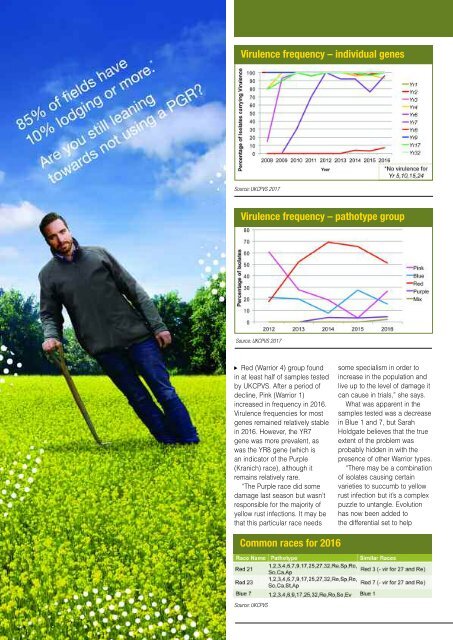In this issue..
CPM-March-Extra-2017
CPM-March-Extra-2017
You also want an ePaper? Increase the reach of your titles
YUMPU automatically turns print PDFs into web optimized ePapers that Google loves.
Virulence frequency – individual genes<br />
Source: UKCPVS 2017<br />
Virulence frequency – pathotype group<br />
Source: UKCPVS 2017<br />
Red (Warrior 4) group found<br />
in at least half of samples tested<br />
by UKCPVS. After a period of<br />
decline, Pink (Warrior 1)<br />
increased in frequency in 2016.<br />
Virulence frequencies for most<br />
genes remained relatively stable<br />
in 2016. However, the YR7<br />
gene was more prevalent, as<br />
was the YR8 gene (which is<br />
an indicator of the Purple<br />
(Kranich) race), although it<br />
remains relatively rare.<br />
“The Purple race did some<br />
damage last season but wasn’t<br />
responsible for the majority of<br />
yellow rust infections. It may be<br />
that <strong>this</strong> particular race needs<br />
▲<br />
some specialism in order to<br />
increase in the population and<br />
live up to the level of damage it<br />
can cause in trials,” she says.<br />
What was apparent in the<br />
samples tested was a decrease<br />
in Blue 1 and 7, but Sarah<br />
Holdgate believes that the true<br />
extent of the problem was<br />
probably hidden in with the<br />
presence of other Warrior types.<br />
“There may be a combination<br />
of isolates causing certain<br />
varieties to succumb to yellow<br />
rust infection but it’s a complex<br />
puzzle to untangle. Evolution<br />
has now been added to<br />
the differential set to help<br />
Common races for 2016<br />
Source: UKCPVS


